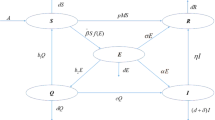Abstract
In this paper we propose a time-space economic model to control the evolution and the spread of a disease. The underlying epidemiological model is formulated as a reaction-diffusion integro-differential partial differential equation. This specific model formulation, supported by empirical data, contains three different terms: a pure diffusion term, a linear growth term, and an integral term. These three terms capture different diffusion channels of a transmissible disease: a local diffusion effect, a temporal effect, and a global diffusion effect. The decision maker aims at deciding the optimal effort to be implemented in order to control the number of infections and, at the same time, minimize the cost of treatment. We analyze the finite horizon case in detail and we provide the closed-form expression of the optimal policy to be implemented to control the epidemic while sustaining economic growth. We also propose two different extensions: The first one considers an infinite horizon model while, the second one, is related to a multi-period framework.
Similar content being viewed by others
References
Aniţa, S., Capasso, V.: A stabilization strategy for a reaction-diffusion system modeling a class of spatially structured epidemic systems (think globally, act locally). Nonlinear Anal. RWA 10, 2026–2035 (2009)
Aniţa, S., Arnăutu, V., Capasso, V.: An Introduction to Optimal Control Problems in Life Sciences and Economics. From Mathematical Models to Numerical Simulation with MATLAB. Birkhäuser, Berlin (2010)
Anita, S., Capasso, V., Kunze, H., La Torre, D.: Optimal control and long-run dynamics for a spatial economic growth model with physical capital accumulation and pollution diffusion. Appl. Math. Lett. 26, 908–912 (2013)
Anita, S., Capasso, V., Kunze, H., La Torre, D.: Dynamics and optimal control in a spatially structured economic growth model with pollution diffusion and environmental taxation. Appl. Math. Lett. 42, 36–40 (2015)
Anita, S., Capasso, V., Kunze, H., La Torre, D.: Dynamics and control of an integro-differential system of geographical economics. Ann. Acad. Rom. Sci. Ser. Math. Appl. 7, 8–26 (2015)
Anselin, L.: Spatial Econometrics: Methods and Model. Springer, Berlin (1988)
Auchincloss, A.H., Gebreab, S.Y., Mair, C., Diez Roux, A.V.: A review of spatial methods in epidemiology, 2000–2010. Annu. Rev. Public Health 33, 107–122 (2012)
Bailey, N.T.: The Mathematical Theory of Infectious Diseases. Hafner Press, Clawson (1975)
Bauer, C., Wakefield, J.: Stratified space-time infectious disease modeling, with an application to hand, foot and mouth disease in China. J. R. Stat. Soc. Ser. C (Appl. Stat.) 67(5), 1379–1398 (2018)
Belotti, F., Hughes, G., Mortari, A.P.: Spatial panel-data models using stata. Stand. Genom. Sci. 17, 139–180 (2017)
Bensoussan, A., Da Prato, G., Delfour, M.C., Mitter, S.K.: Representation and Control of Infinite Dimensional System, 2nd edn. Birkhäuser, Boston (2007)
Bhaskaran, K., Gasparrini, A., Hajat, S., Smeeth, L., Armstrong, B.: Time series regression studies in environmental epidemiology. Int. J. Epidemiol. 42(4), 1187–1195 (2013)
Bosi, S., Camacho, C., Desmarchelier, D.: Optimal lockdown in altruistic economies. J. Math. Econ. 93, 102488 (2021)
Boucekkine, R., Camacho, C., Zou, B.: Bridging the gap between growth theory and the new economic geography: The spatial Ramsey model. Macroecon. Dyn. 13, 20–45 (2009)
Boucekkine, R., Camacho, C., Fabbri, G.: Spatial dynamics and convergence: The spatial AK model. J. Econ. Theory 148(6), 2719–2736 (2013)
Broekaert, J.B., La Torre, D., Hafiz, F.: Competing control scenarios in probabilistic SIR epidemics on social-contact networks. Ann. Oper. Res, in press (2022)
Burbidge, J.B., Magee, L., Robb, A.L.: Alternative transformations to handle extreme values of the dependent variable. J. Am. Stat. Assoc. 83, 123–127 (1988)
Calvia, A., Gozzi, F., Lippi, F., et al.: A simple planning problem for COVID-19 lockdown: a dynamic programming approach. Econ Theory (2023). https://doi.org/10.1007/s00199-023-01493-1
Capasso, V.: Mathematical Structures of Epidemic Systems. In: Lecture Notes in Biomathematics, vol. 97, Springer, Heidelberg, 1993. Second corrected printing (2008)
Cheng, C., Barceló, J., Hartnett, A.S., Kubinec, R., Messerschmidt, L.: COVID-19 government response event dataset (CoronaNet vol 1.0). Nat. Hum. Behav. 4, 756–768 (2020)
Chen, J., Wang, R., Wei, GW.: Review of the mechanisms of SARS-CoV-2 evolution and transmission, 2021 Sep 15. arXiv:2109.08148v1. PMID: 34545334; PMCID: PMC8452100 (2021)
Chowell, G., Sattenspiel, L., Bansal, S., Viboud, C.: Mathematical models to characterize early epidemic growth: A review. Phys. Life Rev. 18, 66–97 (2016)
d’Albis, H., Coulibaly, D., Roumagnac, A., de Carvalho Filho, E., Bertrand, R.: Quantification of the effects of climatic conditions on French hospital admissions and deaths induced by SARS-CoV-2. Sci. Rep. 11, 1–7 (2021)
Desbordes, R.: Spatial dynamics of major infectious diseases outbreaks: A global empirical assessment. J. Math. Econ. 93, 102493 (2021)
Dong, E., Du, H., Gardner, L.: An interactive web-based dashboard to track COVID-19 in real time. Lancet Infect. Dis. 20, 533–534 (2020)
Elhorst, J.P.: The dynamic general nesting spatial econometric model for spatial panels with common factors: further raising the bar. Rev. Reg. Res. 1–19, (2021). https://doi.org/10.1007/s10037-021-00163-w
Elhorst, P.J.: Spatial Econometrics. From Cross-Sectional Data to Spatial Panels. Springer, London (2014)
Federico, S., Ferrari, G., Torrente, M.L.: Optimal vaccination in a SIRS epidemic model. Econ. Theory (2022). https://doi.org/10.1007/s00199-022-01475-9
Finkenstadt, B.F., Grenfell, B.T.: Time series modeling of childhood diseases: A dynamical systems approach. J. R. Stat. Soc. Ser. C (Appl. Stat.) 49(2), 187–205 (2000)
Giamberardino, P.D., Iacoviello, D.: A linear quadratic regulator for nonlinear SIRC epidemic model. In: 23rd International Conference on System Theory, Control and Computing (ICSTCC), 2019, pp. 733-738 (2019)
Grassly, N.C., Fraser, C.: Seasonal infectious disease epidemiology. Proc. Biol. Sci. 273(1600), 2541–50 (2006)
Goenka, A., Liu, L.: Infectious diseases and endogenous fluctuations. Econ. Theor. 50, 125–149 (2012). https://doi.org/10.1007/s00199-010-0553-y
Goenka, A., Liu, L.: Infectious diseases, human capital and economic growth. Econ. Theory 70, 1–47 (2020)
Goenka, A., Liu, L., Nguyen, M.H.: Infectious diseases and economic growth. J. Math. Econ. 50, 34–53 (2014)
Held, L., Hohle, M., Hofmann, M.: A statistical framework for the analysis of multivariate infectious disease surveillance counts. Stat. Model. 5(3), 187–199 (2005)
Hritonenko, N., Yatsenko, Y.: Analysis of optimal lockdown in integral economic-epidemic model. Econ. Theory (2022). https://doi.org/10.1007/s00199-022-01469-7
Hohle, M.: Infectious Disease Modeling (2016)
Kermack, W.O., McKendrick, A.G.: A contribution to the mathematical theory of epidemics. Proc. R. Soc. A 115, 700–721 (1927)
Koelle, K., Pascual, M.: Disentangling extrinsic from intrinsic factors in disease dynamics: A nonlinear time series approach with an application to cholera. Am. Nat. 163(6), 901–913 (2004)
Imai, C., Armstrong, B., Chalabi, Z., Mangtani, P., Hashizume, M.: Time series regression model for infectious disease and weather. Environ. Res. 142, 319–327 (2015)
La Torre, D., Malik, T., Marsiglio, S.: Optimal control of prevention and treatment in a basic macroeconomic-epidemiological model. Math. Soc. Sci. 100, 100–108 (2020)
La Torre, D., Liuzzi, D., Marsiglio, S.: Epidemics and macroeconomic outcomes: social distancing intensity and duration. J. Math. Econ. 93, 102473 (2021)
La Torre, D., Liuzzi, D., Maggistro, R., et al.: Mobility choices and strategic interactions in a two-group macroeconomic-epidemiological model. Dyn. Games Appl. 12, 110–132 (2022)
La Torre, D., Liuzzi, D., Marsiglio, S.: Geographical heterogeneities and externalities in an epidemiological-macroeconomic framework. J. Public Econ. Theory 1–28 (2022). https://doi.org/10.1111/jpet.12576
Mofijur, M., et al.: Impact of COVID-19 on the social, economic, environmental and energy domains: Lessons learnt from a global pandemic. Sustain. Prod. Consumpt. 26, 343–359 (2021)
MacKinnon, J.G., Magee, L.: Transforming the dependent variable in regression models. Int. Econ. Rev. 31, 315–339 (1990)
Naqvi, A.: COVID-19 European regional tracker. Sci. Data 8, 1–14 (2021)
Paul, M., Held, L., Toschke, A.M.: Multivariate modeling of infectious disease surveillance data. Stat. Med. 27(29), 6250–6267 (2008)
Pesaran, M.H.: Estimation and inference in large heterogeneous panels with a multifactor error structure. Econometrica 74, 967–1012 (2006)
Raymond, J., Zidani, H.: Pontryagin’s principle for time-optimal problems. J. Optim. Theory Appl. 101(2), 375–402 (1999)
Smith, C.M., Le Comber, S.C., Fry, H., Bull, M., Leach, S., Hayward, A.C.: Spatial methods for infectious disease outbreak investigations: systematic literature review. Eurosurveillance 20, 1–21 (2015)
Xia, Y., Bjørnstad, O.N., Grenfell, B.T.: Measles metapopulation dynamics: A gravity model for epidemiological coupling and dynamics. Am. Nat. 164(2), 267–281 (2004)
Wakefield, J., Dong, T.Q., Minin, V.N.: Spatio-temporal analysis of surveillance data. In: Held, L., Hens, N., O’Neill, P., Wallinga, J. (eds.) Handbook of Infectious Disease Data Analysis, pp. 455–475. CRC Press, Boca Raton (2019)
World Health Organization: Immunity passports” in the context of COVID-19 - Scientific brief. https://www.who.int/news-room/commentaries/detail/immunity-passports-in-the-context-of-covid-19 (2020)
Author information
Authors and Affiliations
Corresponding author
Additional information
Publisher's Note
Springer Nature remains neutral with regard to jurisdictional claims in published maps and institutional affiliations.
Carmen thanks the grant ANR-17-EURE-0001 for its support.
Rights and permissions
Springer Nature or its licensor (e.g. a society or other partner) holds exclusive rights to this article under a publishing agreement with the author(s) or other rightsholder(s); author self-archiving of the accepted manuscript version of this article is solely governed by the terms of such publishing agreement and applicable law.
About this article
Cite this article
Camacho, C., Desbordes, R. & La Torre, D. A time-space integro-differential economic model of epidemic control. Econ Theory 77, 307–348 (2024). https://doi.org/10.1007/s00199-023-01506-z
Received:
Accepted:
Published:
Issue Date:
DOI: https://doi.org/10.1007/s00199-023-01506-z




